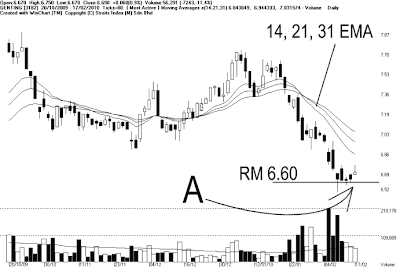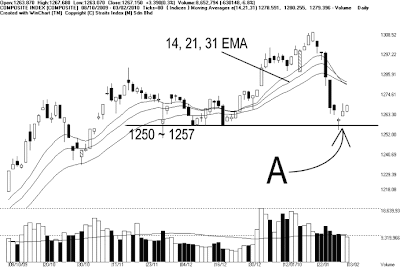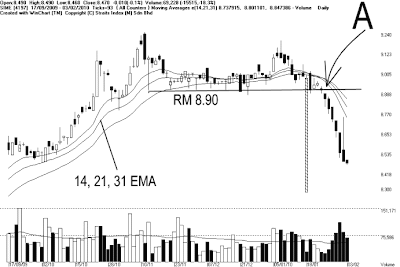
Chart 1: KLCI, from 27/10/2009 to 24/02/2010.
Despite technical indicating that the KLCI is gradually gaining strength, total market volume remains below the 40-day VMA level, suggesting that the overall market participation is still relatively low. This implies that the market confidence is also low.
Nevertheless, there are still some counters that are regaining their positions, while others are still trending down. Investors should pick stock carefully, and only select those counters which has a trend similar to the broad market, and avoid stocks that are still trending down.
Stocks going along with the broad market:
LBS
Chart 2: LBS, from 27/10/2009 to 24/02/2010.
As shown on chart 2, price of LBS went into a consolidation last month, but it was supported by the 14, 21, 31 EMA. As indicated by A, as the KLCI pick up some strength, price of LBS rebounded, and remained above the 14, 21, 31 EMA, thus suggesting that it might be resuming its uptrend, and the 14, 21, 31 EMA shall serve as the dynamic support.
If price should remains supported by the 14, 21, 31 EMA, the uptrend shall continue, and immediate resistance is at RM 0.85 level. If price should break above the RM0.85 resistance with strong volume, more upside movement is expected for LBS. If price should break below the 14, 21, 31 EMA, it would be a signal to take profit.
| 4 Q Rolling PER | 13.07 times | Dividend Yield | 0.63% |
| Dividend | Dividend Yield | Net Profit Ratio | |
| 31/12/2009 | 11 sen | 2.01 | 15.92% |
| 31/12/2008 | 3.25sen | 4.06% | 5.58% |
| 31/12/2007 | 1.90 sen | 0.63% | 13.85% |
| 31/12/2006 | 6.50sen | 1.56% | 10.49% |
| 31/12/2005 | 6.50 sen | 1.46% | 12.74% |
Table 1: LBS, yearly dividend, dividend yield, and net profit ratio.
Supermx
Chart 3: Supermx, from 27/10/2009 to 24/02/2010.
As shown on chart 3, price of Supermx resumed its uptrend, and breaking above the T1 mid term downtrend line as the KLCI pickup strength. As indicated by A, the 14, 21, 31 EMA is now serving as the dynamic support, thus the uptrend remains intact.
Immediate resistance for Supermx is at RM 6.18, and some profit taking activities is expected near this level. Nevertheless, it is a good idea to hold on to the stock as long as the 14, 21, 31 EMA is still supporting the uptrend. If price should break below the 14, 21, 31 EMA, it would be a signal to take profit.
| 4 Q Rolling PER | 13.07 times | Dividend Yield | 0.63% |
| Dividend | Dividend Yield | Net Profit Ratio | |
| 31/12/2009 | 11 sen | 2.01 | 15.92% |
| 31/12/2008 | 3.25sen | 4.06% | 5.58% |
| 31/12/2007 | 1.90 sen | 0.63% | 13.85% |
| 31/12/2006 | 6.50sen | 1.56% | 10.49% |
| 31/12/2005 | 6.50 sen | 1.46% | 12.74% |
Table 2: Supermx, yearly dividend, dividend yield, and net profit ratio.
Stocks going against the broad market:
SAAG
Chart 4: SAAG, from 27/10/2009 to 24/02/2010.
As indicated by A, price of SAAG is still trending down below the falling 14, 21, 31 EMA, and continuously making new low. This proves that the down trend is still intact, despite the strong rebound of the broad market, local and abroad.
Since SAAG is making new low, there is no reliable support sighted at the moment, but the 14, 21, 31 EMA shall remains at the dynamic resistance. In other words, provided that SAAG is still resisted by the falling 14, 21, 31 EMA, the bearish outlook is still intact.
| 4 Q Rolling PER | 36.90 times | Dividend Yield | 0% |
| Dividend | Dividend Yield | Net Profit Ratio | |
| 31/12/2008 | 0 sen | 0% | 5.63% |
| 31/12/2007 | 5 sen | 0.88% | 5.87% |
| 31/12/2006 | 3sen | 1.86% | 4.56% |
| 31/12/2005 | 0 sen | 0% | 1.47% |
| 31/12/2004 | 0 sen | 0% | -1.35% |
Table 3: SAAG, yearly dividend, dividend yield, and net profit ratio.
SCOMI
Chart 5: Scomi, chart from 27/10/2009 to 24/02/2010.
As shown on chart 5, despite the strong KLCI rebound, price of Scomir remains in the downtrend while resisted by the 14, 21, 31 EMA, which is serving as the dynamic resistance. Fortunately, as indicated by A, price of Scomi found at temporary support around RM 0.40, and now consolidating. If price should break above the 14, 21, 31 EMA, with strong volume, it would break away from the downtrend.
But until then, the current reading of Scomi is still weak. If price should break below the RM0.40 level, it would be making new low, thus resuming its downtrend movement after this consolidation. Therefore, it would be a signal to cut loss.
| 4 Q Rolling PER | 4.39 times | Dividend Yield | 1.22% |
| Dividend | Dividend Yield | Net Profit Ratio | |
| 31/12/2008 | 0.5 sen | 1.49% | 5.53% |
| 31/12/2007 | 1.25 sen | 1.10% | 3.58% |
| 31/12/2006 | 1.5sen | 1.49% | 5.37% |
| 31/12/2005 | 1.20sen | 1.20% | 16.19% |
| 31/12/2004 | 0.6 sen | 0.36% | 10.41% |
Table 4: Scomi, yearly dividend, dividend yield, and net profit ratio.
Conclusion:
When the market turns bullish, investors have to always confirm the bullishness with volume. If volume should failed to break above the 40-day VMA level, it suggests that the rally was mostly on selective counters, thus picking the right stock would be harder. Therefore, investors should pick stocks that has the similar movement with the broad market, avoid stocks that are still trending down, despite blue chips or KLCI components.
Copyright © 2009 Straits Index (M) Sdn BhdImportant Disclaimer:These content provided by Straits Index (M) Sdn Bhd is solely for education and information purposes only, and do not suggest any investment advices. All information displayed are believed to be accurate and reliable. Interpretation of the data or analysis is at the reader's own risk. Straits Index (M) Sdn Bhd reserves the rights but obligations to update, admen, or even terminate the materials. 重要声明:以上的内容由海峡指数(马)私人有限公司提供,纯粹是教育性质, 并不是任何的投资忠告。所有资料显示认为是准确和可靠的。对数据或分析的解释和用途是在于用户自己的风险。海峡指数(马)有限公司持有保留及义务更新,甚 至终止材料的权利。

























